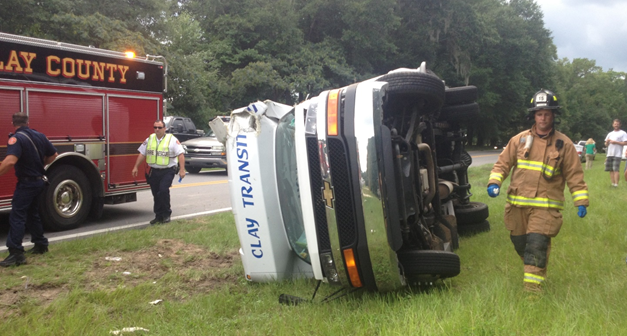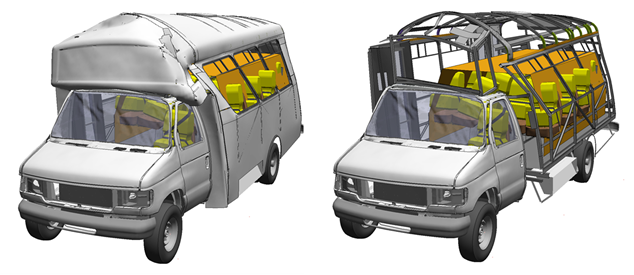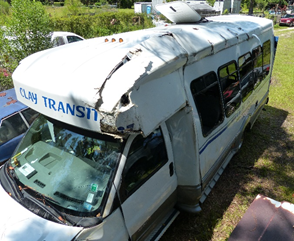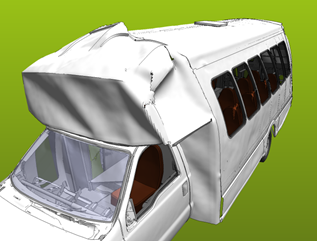16 July, 2014
A recent roadway crash in Florida involving an aging passenger in paratransit bus resulted in minor injuries to the passenger while the bus driver had no injuries. The passenger compartment of the bus was proven to be safe. Compared to typical crashes, the reduced injuries in this case can be attributed to the improved design of paratransit buses based on the computational mechanics technology developed by researchers at the Center for the Accessibility and Safe Transportation for the Aging Population (ASAP).
On July 16, 2014 Janet S. called the Clay County Council on Aging to request a ride on a paratransit bus. She was an older women who had an appointment with her doctor when nobody else from her close family was available to give her a ride. At 3:30 pm the paratransit bus that Susan rode in was struck by a passenger car and lost control. State Trooper CW Heaton wrote in his Accident Report:
V01* was traveling southbound on CR-209 (Russell Road). V02** was traveling northbound on CR-209 (Russell Road). V01 traveled across the center line onto the northbound shoulder of the roadway as V02 was approaching. Still southbound V01 veered right back onto the roadway striking V02 in the right rear side with the front of V01. V02 spun left overturning on the east shoulder of the roadway into a ditch. V02 came to rest on its right side facing south
*V01 = '2014 Toyota Camry
**V02 = Turtle Top paratransit bus on '2013 Chevy chassis

With only minor injuries, Janet S. was taken by EMS to the local Baptist Clay Hospital while the bus driver walked away from this serious accident.
The Crashworthiness and Impact Analysis Laboratory (CIAL) was established by Dr. Jerry Wekezer at FAMU-FSU College of Engineering in 1995. CIAL research interests and expertise include applied computational mechanics and numerical analysis, non-linear, dynamic finite element methods, computer modeling, contact, impact and penetration problems, crashworthiness, safety, vulnerability and survivability, energetic materials, detonation science and progressive collapse of structures. Most research projects are conducted using LS-DYNA non-linear, 3-D, dynamic, explicit finite element code. Past projects were sponsored by: the Florida Department of Transportation, National Science Foundation, Federal Highway Administration, Federal Transit Administration, Army Research Lab, Defense Threat Reduction Agency, and others.
Computational mechanics technology is especially effective in crashworthiness and accident mitigation studies. The capabilities of CIAL attracted an attention of the Florida Department of Transportation (FDOT) Transit Office. The FDOT Transit Office manages state requisitions of over 300 paratransit buses per year through its Transit Research, Inspections and Procurement Services (TRIPS) program. TRIPS customers include transportation programs operated by nonprofit or faith-based organizations, and elder care facilities that provide transportation for their residents. Paratransit is also required by the ADA to transport passengers who are unable to use the public bus system due to age, disability or injury.
The primary objective of the CIAL TRIPS project is to improve the overall crashworthiness of paratransit buses acquired through TRIPS Program contracts. This is accomplished by splitting all project tasks into two major areas:
CIAL researchers have developed five finite element models of actual buses considered by the State until now. It usually takes a year to develop and validate each model which currently consist of approximately 1,000,000 finite elements. 3-D AutoCAD drawings provided by bus manufacturers are used as a starting point and the resulting FE model is highly detailed (see Figure 2). CIAL has also developed an extensive laboratory testing program of critical, structural elements and of entire buses. It includes rollover tests and side impact tests. A suitable tilt table and a testing impact pendulum were designed and constructed for CIAL in Tallahassee (Figure 4).




Click on the video above to play (or pause) the clip which shows a side-by-side comparison of a full scale bus rollover test with its computational mechanics analysis.
CIAL testing of bus connections and of the entire buses is based on dynamics rather than on static testing. This philosophy is certainly closer to actual accidents seen on our highways. It is also a basis of the "Crash and Safety Testing Standard for Paratransit Buses Acquired by the State of Florida" which was used for bus testing since 2007.
"Crashworthiness Assessment of a Paratransit Bus", Leslaw Kwasniewski, Hongyi Li, Ravi Nimbalkar and Jerry W. Wekezer. Elsevier International Journal of Impact Engineering. (Article also published online via ScienceDirect: https://authors.elsevier.com/sd/article/S0734743X05000709). Hard copy: Volume 32, Issue 5, pp. 883-888, May 2006.
"Assessment of Passenger Security in Paratransit Buses", Andrzej Morka, Leslaw Kwasniewski and Jerry W. Wekezer. Journal of Public Transportation, Special Issue: Transit Safety and Security, https://www.nctr.usf.edu/jpt/pdf/JPT%208-4S%20Morka.pdf, ISSN 1077-291X, Volume 8, No. 4, pp. 47-64, October 2005.
"Material and Structural Crashworthiness Characterization of Paratransit Buses", Mark F. Horstemeyer, Hongyi Li, Jeff Siervogel, Leslaw Kwasniewski, Jerry W. Wekezer, Brian Christian, Garry Roufa. International Journal of Crashworthiness. https://www.informaworld.com/smpp/content~content=a783389084~db=all~order=page, pp. 509-520, Volume 12, Issue 5, 2007.
"Structural Response of Paratransit Buses in Rollover Accidents". Krzysztof Cichocki, Jerry W. Wekezer. International Journal of Crashworthiness. https://www.informaworld.com/smpp/content~content=a782255138~db=all~order=page , Vol. 12, No. 3, pp. 217-225, 2007.
"Crash and Safety Assessment Program for Paratransit Buses", Leslaw Kwasniewski, Jeff Siervogel, Cezary Bojanowski, Jerry W. Wekezer and Krzysztof Cichocki. Elsevier International Journal of Impact Engineering. https://dx.doi.org/10.1016/j.ijimpeng.2008.05.003. DOI information: 10.1016/j.ijimpeng.2008.05.003, Vol. 36, Issue 2, pp. 235-242, February 2009.
"Safety Assessment of Wheelchair Occupants in Paratransit Buses", Cezary Bojanowski, Leslaw Kwasniewski, Jerry Wekezer. International Journal of Human Modeling and Simulation. https://www.inderscience.com/search/index.php?action=record&rec_id=22475&prevQuery=&ps=10&m=or. Vol. 1, No. 2, pp. 174-196, November 2008.
"Effectiveness of ECE R66 and FMVSS 220 Standards in Rollover Crashworthiness Assessment of Paratransit Buses". Bronislaw Gepner, Cezary Bojanowski, Leslaw Kwasniewski, Jerry Wekezer. International Journal of Automotive Technology, https://link.springer.com/article/10.1007/s12239-014-0061-3, DOI: 10.1007/s12239-014-0061-3, Vol. 15, Issue 4, pp. 581-591, June 2014.
Florida Department of Transportation August 10, 2007, Crash and Safety Testing Standard for Paratransit Buses Acquired by the State of Florida, https://www.dot.state.fl.us/transit/Pages/CrashSafetyTestingStandardsFullDocument.pdf
Dr. Sungmoon Jung, Associate Professor, Phone: 850-410-6386, E-mail:sjung2@fsu.edu
Dr. Jerry Wekezer, Professor Emeritus, Phone: 850-410-6542, E-mail: jwekezer@fsu.edu
URL: https://www.eng.fsu.edu/~wekezer/
Crashworthiness and Impact Analysis Laboratory
FAMU-FSU College of Engineering, Room B-327
Department of Civil and Environmental Engineering
2525 Pottsdamer Street
Tallahassee, FL 32310-6046